
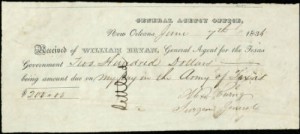
$200 pay certificate for Alexander Wray Ewing (June 7, 1836), for “my pay in the Army of Texas.” Ewing served as surgeon general of the Texas army and, two months prior, had treated Sam Houston at the battle of San Jacinto. — (available for high-resolution download through our Digital Library or for further study via our Early Texas Documents Collection)
The digitization of the Early Texas Documents Collection which has recently been published has been a monumental task several years in the making. With nearly 1,300 items, the documents trace not only the activities of prominent Texans and founders, such as Sam Houston and Stephen F. Austin, but give researchers a glimpse into what life was like for Texans in the early 19th through transactions involving land, finances, legal matters, and in some cases chattel and slaves. In addition, military documents chronicle the Battle of San Jacinto between General Sam Houston and Santa Anna’s forces. There are also military scrips that document the pay soldiers received for their time of service within the Texas Army and Navy.
Genealogists may also find the documents of interest as the subjects of their research may have written letters, or their names may appear on financial or legal documents contained within the collection. The collection also contains early examples of currency utilized during the Republic era. Selections of these currencies have been featured in the exhibit On the Run: Currency, Credit and Capitals of the Republic of Texas this past June at the Texas Capital Visitors Center in Austin. In short, the collection contains something for everyone.
Lauren Bacall, a legend (though she despised the word) and icon of Hollywood’s golden era who taught the world how to whistle, died in New York on Tuesday.
Born Betty Joan Perske to working-class immigrants in Brooklyn, her parents divorced when she was six years old. Her mother, Natlie Perske (maiden name, Weinstein-Bacal) moved to Manhattan and young Betty Joan would go on to usher theaters on Broadway and model dresses on Seventh Avenue before her enigmatic beauty drew inquiries from Hollywood. She left for the West Coast in 1942, reemerging as Lauren Bacall (“Lauren” at the behest of producer and director Howard Hawks, the additional “L” to assist in pronunciation), catching the silver screens aflame with a mystique and unmistakable, smoldering vocal delivery.
“Betty” to long-time friends and family, but always “Baby” to “Bogie,” she sometimes bristled at the attempts of others to define her in the context of that other iconic actor, her screen foil, and her husband (until his death in 1957), Humphrey Bogart. “Being a widow,” she once told an interviewer, “is not a profession.” Bacall and Bogart sparked on and off screen in To Have and Have Not (1944), married in 1945, and would go on to star opposite one another in The Big Sleep (1946), Dark Passage (1947), and Key Largo (1948).
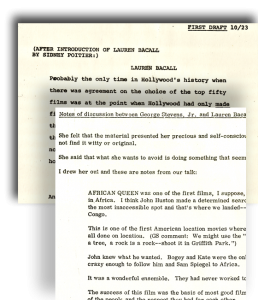
detail from Larry McMurtry’s notes, working with Lauren Bacall and George Stevens, Jr., from the Larry McMurtry Papers
Others will offer up more appropriate insights into the artistry and legacy of Bacall. Today, however, while obituaries abound generously peppered with the name “Bogart,” as she’d once predicted and lamented long before her passing, an interesting item from the Larry McMurtry Papers provides even more context to the Bacall-Bogart dynamic. In 1977 McMurtry worked with Bacall and George Stevens, Jr. as part of “The Stars Salute America’s Greatest Movies,” honoring the best 500 films to date. Bacall was to introduce The African Queen (1951, John Huston), starring her late husband.
McMurtry quotes Bacall on her recollections of the filming of African Queen and Bogart’s co-star, Katharine Hepburn: “John knew what he wanted. Bogey and Kate were the only two stars crazy enough to follow him and [producer] Sam Spiegel to Africa… It was the beginning of my friendship with Katie–an important part of my life and it still is.” Twenty years after Bogart’s death, however, it was clear he still served as a foil. Reflecting on their conversation, McMurtry writes, “In terms of the introduction, she would like it to be clear that she has a reputation of her own–that she is not simply Bogey’s widow. Obviously, it will be clear in her presentation that it is not purely coincidental that she is doing the introduction to AFRICAN QUEEN which starred Bogey.”
She must have known, however, that her legacy remains quite her own. Honored throughout her life by a list that includes the Screen Actors Guild, the Tony Awards, and the Golden Globes, she also received a National Book Award for her autobiography By Myself (1978). While she does recount those famous loves lost (Frank Sinatra once reportedly proposed to Bacall), she also recounts her rise as a starlet in a very particular heyday for Hollywood, including this interesting tidbit on how she went about acquiring her signature sound at the direction of Hawks:
He wanted me to drive into the hills, find some quiet spot, and read aloud. He felt it most important to keep the voice in a low register. Mine started off low, but what Howard didn’t like and explained to me was, “If you notice, Betty, when a woman gets excited or emotional she tends to raise her voice. Now, there is nothing more unattractive than screeching. I want you to train your voice in such a way that even if you have a scene like that your voice will remain low.” I found a spot on Mulholland Drive and proceeded to read The Robe aloud, keeping my voice lower and louder than normal. If anyone had ever passed by, they would have found me a candidate for the asylum. Who sat on mountaintops in cars reading books aloud to the canyons?
The Larry McMurtry Papers are available for study, along with twenty-one other Contemporary Literature collections, in the University of Houston Special Collections Reading Room.
Many of the books featured in our current exhibition LGBTQI Literature: Celebrated Classics and Contemporary Works have been adapted into acclaimed movies and TV miniseries. From eighties costume drama Brideshead Revisited to this spring’s HBO film The Normal Heart, the stories of people who identify as LGBTQI have made for compelling drama on the big and small screen.
With the dog days of summer upon us, we recommend that you come view the exhibition, stop off for lunch or dinner at Eric’s Restaurant on campus, and then unwind at home with one of the following:
Those who are suffering from Downton Abbey withdrawal might enjoy the British miniseries Brideshead Revisited (1981), the tale of a friendship that develops between two young men at Oxford in the decade following WWI. Based on the novel by Evelyn Waugh, Brideshead… made a star of Jeremy Irons.
Desert Hearts (1985), directed by Donna Deitch and based on the novel Desert of the Heart by Jane Rule, is considered a classic of lesbian film. It centers on the realistic romance between divorcing housewife Vivian and casino worker Cay in Reno, Nevada.
Steven Spielberg directed The Color Purple (1985), an adaptation of the Pulitzer Prize-winning novel by Alice Walker. In it, main character Celie (played by Whoopi Goldberg) finds her life changed by an affair with the beautiful blues singer Shug.
Armistead Maupin’s Tales of the City (1993) was the first of three miniseries based on the writer’s popular books about life in a San Francisco apartment building in the 1970s. It starred a less well-known Laura Linney as the naive new tenant Mary Ann, and Olympia Dukakis as landlady Mrs. Madrigal. Various straight and gay neighbors with their own stories rounded out the characters.
The script for the two-part HBO production of Angels in America (2003) was adapted by Tony Kushner from his play about the AIDS epidemic in Reagan’s America. Angels… won 11 Emmy Awards including acting nods for Al Pacino as closeted conservative attorney Roy Cohn, and Jeffrey Wright as the compassionate nurse Belize.
Brokeback Mountain (2005) started out as a story by Annie Proulx in her 1999 collection Close Range: Wyoming Stories. The tale of two ranch hands who fall in love was adapted into a full-length screenplay by Larry McMurtry and his writing partner Diana Ossana. The Ang Lee-directed film starred Jake Gyllenhaal and the late Heath Ledger as the star-crossed Western lovers.
In May 2014, miniseries The Normal Heart debuted on HBO. Based on Larry Kramer’s 1985 play about activism during the early years of the AIDS crisis, it starred Mark Ruffalo and Julia Roberts, and will be released on DVD later this month.
LGBTQI Literature: Celebrated Classics and Contemporary Works will be on view on the 1st floor of MD Anderson Library through Sept. 26, 2014.
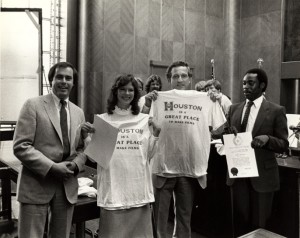
“Houston is a Great Place to Make Films” / from the production of Adam, pictured left to right, Steve Moore of GHCVC, Jo Beth Williams, Daniel J. Travanti, and Melvia Tennant of GHCVC (1983) / photo by Marianita Paddock, Paddock Greater Houston Convention & Visitors Council Records
The University of Houston Special Collections is proud to announce the recent publication of the Paddock Greater Houston Convention & Visitors Council Records finding aid.
These papers of Mildred and Harold Paddock show research potential in relation to their documentation of work conducted by the the Greater Houston Convention & Visitors Council, with most materials coming from the time their daughter, Marianita Paddock, worked with the GHCVC. The first series in this collection deals specifically with these types of materials, containing correspondence, speeches, press releases, and other promotional publications. Particularly interesting is a look into Houston’s late twentieth century development as a destination for large and small screen productions via the sub-series “Film in Houston,” containing press releases, industry journals, production schedules, and photographs capturing behind-the-scenes glimpses of productions, the city, and the iconic locales used in filming (predominantly from the 1980s). Among the films documented in the records are Middle Age Crazy (starring Bruce Dern), Adam (based on the true story of Adam Walsh’s kidnapping), and Murder at the World Series (which counted the Astrodome among its filming locations).
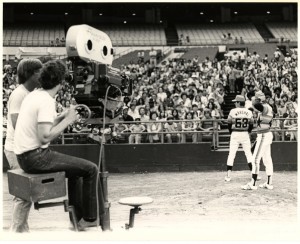
Filming Murder at the World Series (1976) / photo by George Wilkins, Paddock Greater Houston Convention & Visitors Council Records
The second series in this collection contains memorabilia related to the city of Houston and the state of Texas at-large, including bulletins, mailers, programs, and tickets collected by the Paddocks predominantly from the mid to late twentieth century. Of particular interest, and included among these materials, is a recording of the moon landing from 1969.
These materials, further expanding our larger Houston & Texas History Collection, are available for study in the Special Collections Reading Room during our normal summer hours. We look forward to seeing you and assisting you in your research!
Let’s follow recent posts about Kenneth Bentsen’s Philip G. Hoffman Hall (PGH), with a look at his Agnes Arnold Hall (1968) next door. Like PGH, Agnes Arnold is a good modern design and its success has much to do with Bentsen’s use of contrast. An important principle of architectural design, the contrast between thick and thin, heavy and light, solid and transparent enlivens a building’s form.
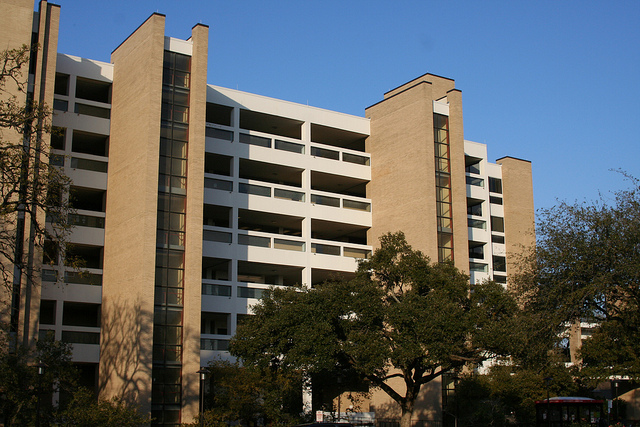
Kenneth E. Bentsen, Agnes Arnold Hall, University of Houston (1968), south elevation (Photo Eric E. Johnson, by permission)
At Agnes Arnold the vertical lines of the towers contrast with the horizontal lines of the stacked classroom levels. The texture and color of the brown brick towers contrasts with the smooth white spandrels and railings. The solid brick contrasts with the transparent glass. Agnes Arnold Hall is also effective because of its layered façade, which is much more sculptural than Bentsen’s very reserved PGH design. Here the architect achieves this sculptural effect by placing the corridors on the edge of the building and opening them to the outside. The surface is cut away and you can see deep within the building.
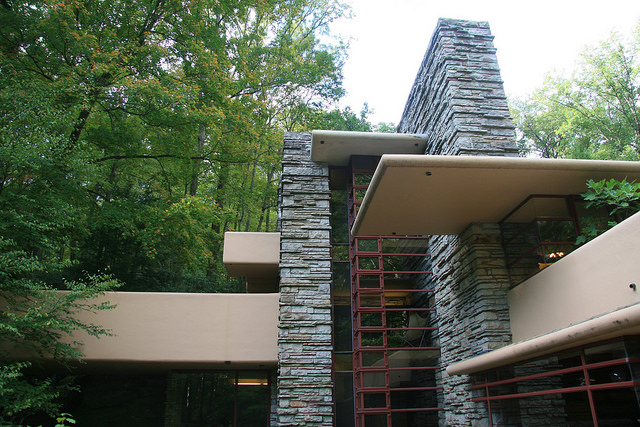
Frank Lloyd Wright, Fallingwater, Bear Run, PA (1936), detail. Photo J.P. Otto, all rights reserved.
You see these same formal principles at work in another successful modern design where contrasting lines, colors, and textures animate the façade of Frank Lloyd Wright’s famous house, “Fallingwater.”
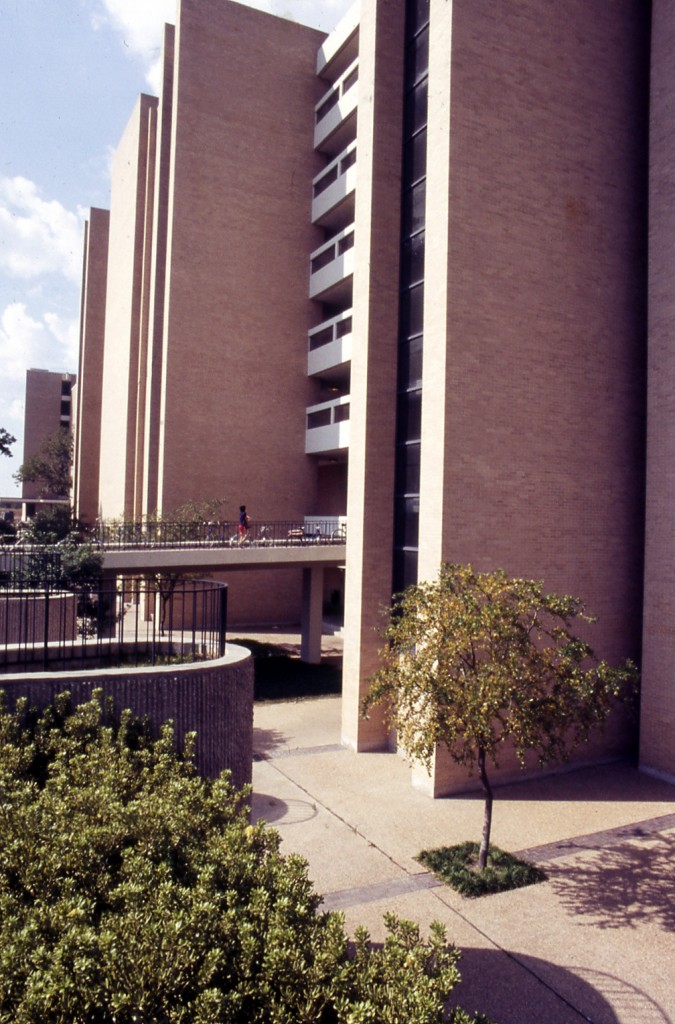
Agnes Arnold Hall is entered from a bridge over the basement courtyard. Kenneth E. Bentsen Architectural Papers
Architects are encouraged to design in three dimensions, not just two. They are intrigued by the idea of space that flows through the building vertically as well as horizontally. You see this in the three-level lobby of Agnes Arnold, where the ground floor is open not just to the level above but to the level below as well. In addition, the building is entered from the south over a dramatic bridge that spans the open courtyard at the basement level. From the street the building appears to rise from an open pit.
The Kenneth E. Bentsen Architectural Papers are housed in the library’s Special Collections department and are currently being processed. Pictures of Agnes Arnold Hall and other campus buildings are available in the University of Houston Buildings Collection of the UH Digital Library.